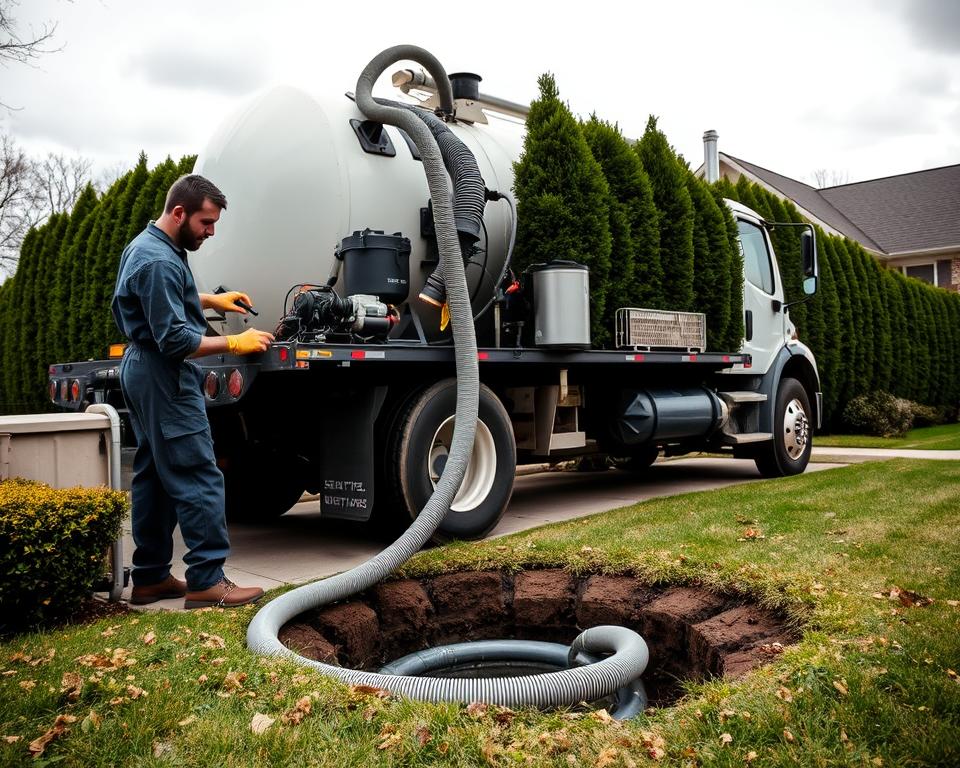Septic Air Pump: Comprehensive Guide for Residential Users
Ever pondered on what drives your air-treated Septic system’s efficiency? The aeration Pump is the unrecognized key component indispensable for your system. With this resource, property owners will get valuable knowledge on the Septic air pump’s importance. It’s critical for a well-functioning, well-run Septic system.
Understanding the necessity of a Septic tank air Pump can optimize your Septic system’s operation using septic system service. It also preserves your home equity and environmental health. The resource below will introduce All in Sanitation, a well-regarded Septic industry specialist. They’re equipped to meet your Septic aerator Pump requests.
Key Insights
- The Septic air Pump is vital for air-driven Septic tanks.
- Servicing your Septic system air Pump can optimize overall system efficiency.
- Regular checks increase the durability of your Septic tank air Pump.
- Picking the right Septic aerator Pump is key for maximum operation.
- All in Sanitation supplies specialized services for Septic air Pump requirements.
Exploring Aerobic Septic Systems
Aerobic Septic systems deliver a more effective waste treatment alternative by employing oxygen. This system employs aerobic bacteria flourishing in well-oxygenated environments. These bacteria are better in decomposing organic matter. With the help of Septic aerator Pumps, these systems maintain a continuous oxygen supply, enhancing the waste decomposition process.
These systems stand out in reducing sludge buildup, due to the effectiveness of aerobic bacteria. This reduction in solid waste means reduced upkeep and tank Pump-outs is needed. Additionally, they reliably process wastewater, producing reduced odors. This creates a more pleasant environment for homeowners and the community overall.
To ensure these systems run successfully, it’s crucial to grasp the key Septic system components. These include the Septic tank, aeration chamber, and effluent Pump. Each component has a crucial role, especially the air Pump. It injects oxygen into the tank, vital for the aerobic bacteria’s activity.
Significance of the Septic Air Pump
The Septic air Pump is central in the running of aerobic Septic systems. It serves as the system’s “air provider,” delivering the necessary oxygen needed. This oxygen helps aerobic bacteria to prosper and break down waste quickly. If the Pump malfunctions, the system’s efficiency diminishes, bringing about sludge buildup and possible odors.
Such issues can disrupt Septic system operations and pose environmental hazards. By recognizing how essential the Septic air Pump is, homeowners can act preemptively. They can keep its best function through consistent upkeep. This stops failures, prevents costly repairs, and maintains the aerobic system’s health.
Primary Gains of Using a Septic Air Pump
Running a Septic air Pump significantly boosts the effectiveness of Septic systems. Septic air Pumps are vital as they accelerate the decomposition of waste. This is accomplished by oxygenating the treatment process, promoting aerobic bacteria growth. These bacteria are essential for successful waste treatment.
They’re also important in lowering foul smells. With more active aerobic processes, waste is treated faster, thus cutting down odors. This makes the environment more pleasant for homeowners.
Another significant benefit is the cut in sludge accumulation. Consequently, tanks need less frequent Pumping, conserving both money and time. Enhanced processing not only reduces spending but also increases the lifespan of the drain field.
Servicing these Pumps correctly means reduced repair costs and satisfying regulatory standards. Thus, the advantages of Septic air Pumps are not only for homeowners. They also enhance environmental health by raising waste management practices.
| Benefit | Description |
|---|---|
| Fast Waste Breakdown | Increased aerobic activity hastens the decomposition process. |
| Minimized Odor Emissions | Optimized treatment efficacy produces fewer odors. |
| Reduced Sludge Buildup | Minimal Pumping and maintenance are called for. |
| Extended Drain Field Life | Better treatment means a healthier drain field. |
| Cost Savings | Lower chance of repairs and regulatory compliance cost. |

Picking an Ideal Septic Air Pump
Selecting the right Septic air Pump is critical for an optimized aerobic system. Homeowners should assess various factors for the perfect selection. The capacity of the tank and the airflow needs play a crucial role the Pump’s efficiency.
To make an informed choice, it’s useful to understand the air Pumps available. There are mainly two types: linear diaphragm Pumps and rotary vane Pumps. Each provides distinct advantages, which should be aligned with your home’s individual circumstances and how it operates.
Electric efficiency also deserves attention. Opting for a Pump that minimizes energy use while supplying the needed airflow can yield noticeable cost cuts. Assistance from All in Sanitation experts can be invaluable. They make certain the Pump you choose fits your system’s requirements perfectly.
Popular Categories of Septic Air Pumps
Homeowners can choose intelligently by being aware of the different Septic air Pumps available. There are mainly two types: diaphragm Pumps and rotary vane Pumps. Each has its specific functions and benefits.
Diaphragm Pumps, famous for their quiet operation, are favored for residential Septic systems. They maintain energy efficiency while ensuring stable air output. Their reliable performance matches smaller systems, appealing to many homeowners.
Rotary vane Pumps, however, are better suited for extended or commercial systems. These Pumps deliver greater output, essential in handling bigger loads. Their durable build allows efficient operation in large-scale Septic systems.
| Type of Pump | Best Use | Advantages |
|---|---|---|
| Diaphragm Pumps | Residential Systems | Quiet operation, energy-efficient, reliable air flow |
| Rotary Vane Pumps | Larger or Commercial Systems | Powerful performance, high capacity, durable construction |
Recognizing the variations in Septic air Pumps is essential for upgrades or replacements. Each Pump type brings particular attributes to meet various needs. This secures top performance for any system.
Clues Pointing to a Septic Air Pump Replacement
Homeowners must monitor Pump failure signs in their Septic systems. Some signals show the need for a Septic air Pump replacement. These ensure continued performance. Catching these early prevents bigger issues.
Signs of potential problems include:
- Unusual noises from the Pump, like grinding or buzzing, might mean internal damage.
- A clear lack of air output indicates the Pump isn’t working well, affecting efficiency.
- Repeated electrical problems, such as power trips or flickering lights, could suggest overloading.
- Visible damage on the Pump unit, with splits or leaks, calls for quick action.
- Offensive smells in the yard often signal a compromised Pump, meaning ineffective effluent aeration.
Finding these signs early prevents high repair bills or total system failure. Carrying out regular checks assists in finding these issues. It also demonstrates if you need a new Septic air Pump.
Maintenance Tips for Your Septic Air Pump
For an well-running Septic air Pump, regular maintenance is essential. This makes sure that your system runs well. Homeowners can follow several practical care strategies for maximum results.
Bi-annually, perform a careful inspection for wear or damage. It is also important to replace the filters as suggested. This stops clogs that could reduce efficiency.
The Pump should sit on a firm base to cut vibrations, which could wear it over time. A protective cover is important too. It guards against debris and water, keeping the Pump’s functionality.
Regular servicing can notably lengthen the life of your Pump. In turn, this benefits the Septic system’s performance as a whole.
| Maintenance Task | Frequency | Benefits |
|---|---|---|
| Inspect Pump for damage | Every 6 months | Catches problems quickly |
| Replace filters | As needed | Maintains airflow |
| Check surface stability | Annually | Limits wear |
| Clear debris around Pump | Monthly | Stops blockages |
Installing Your Septic Air Pump
Accurate installation of your Septic air Pump is vital for its optimal operation. To start, select a safe, moisture-free area for placement. The chosen spot should safely support the Pump’s weight without issue.
To reliably install your Pump on your own, use the following guidelines:
- Assemble all necessary items, including the Pump, a power source, and hose fittings.
- Thoroughly review the manufacturer’s guidelines before kicking off your installation.
- Confirm every connection is proper to eliminate air leaks that reduce performance.
- After assembly, run a test to check the system works as intended.
If the installation process seems daunting, call All in Sanitation. Their professionals can sidestep common errors, making sure your setup meets relevant safety requirements.
Benefits of Choosing All in Sanitation for Your Septic Air Pump Solutions
When choosing a Septic service provider, the choice is important. All in Sanitation sets itself by providing dependable Septic air Pumps. They cater to diverse homeowner requirements with a comprehensive selection of quality products. This ensures customers find an appropriate match for their Septic systems.
What clearly distinguishes All in Sanitation is not solely their extensive product lineup. Their commitment to exceptional customer service is also critical. Homeowners benefit from expert advice, guiding them towards trusted Septic solutions. This partnership is important to tailor each solution to match specific needs.
All in Sanitation also emphasizes aftercare to ensure lasting satisfaction. Their commitment goes beyond the initial sale. They supply ongoing support to maintain Septic systems operating efficiently for the foreseeable future.
Expense Overview for Septic Air Pumps
Knowing the price factors tied to Septic air Pumps is vital for homeowners operating aerobic Septic systems. Up front, one faces the purchase price, which includes the Pump and needed accessories. Installation expenses vary, in line with the system’s complexity and any adjustments required.
Ongoing upkeep forms an additional cost layer. Regular inspections can ward off bigger issues, in the long run yielding savings. Homeowners should set aside funds for Septic maintenance to retain the Pump’s effectiveness and service life. Such planning prevents expensive repairs later on, showing the benefit of proactive maintenance.
| Cost Component | Average Cost Range |
|---|---|
| Septic Air Pump | $500 – $1,200 |
| Installation | $300 – $800 |
| Annual Maintenance | $150 – $400 |
| Potential Repair Costs | $1,000 – $5,000 |
Breaking down Septic air Pump expenses into distinct parts aids homeowners in cost forecasting. This detailed approach ensures the system’s steady performance and their confidence.
To Conclude
For homeowners with aerobic Septic systems, servicing Septic units is vital. The appropriate Septic air Pump optimizes waste processing and lengthens your system’s life. Sticking with routine maintenance and immediately resolving issues stops high expenses and disruptions.
Picking a Septic air Pump requires consideration. This guide outlined how to make smart choices about installation and replacement. With All in Sanitation’s support, you can handle your Septic systems’ complexities confidently.
Looking after your Septic air Pump supports your system’s performance and service life. It provides a smooth and successful operation over time. Bear in mind, your home’s wastewater management benefits greatly from regular attention.


